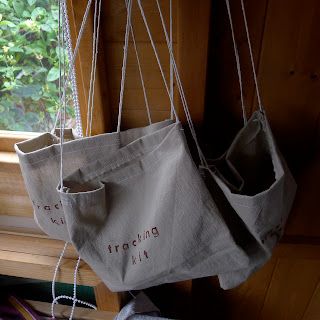When Anne-Marie Culhane asked me to lead a walk as part of her Back to Back series for the Fruit Routes project, the idea of Paths of Desire was strong. Anne-Marie had created a map of a route that leads to where a number of fruit trees and berried hedgerows can be found around the Loughborough campus, and this seemed like a path for those that desire the sweet tastes and juicy bounty. However, in response to the project, the original idea of Paths of Desire developed a new turn.
The notion behind the Back to Back series is that different artists and others (ecologists, historians, poets etc.) lead walks which respond to each others' walk, taking the walk before as a lead but also diverging away from it. The walk before mine was by artist/poet Paul Conneally and ecologist Ed Darby.
Paul and Ed had started thinking about the other users of the Fruit Routes, the fauna. Through their project they wanted to give the fauna a voice, by creating "Twoots", or non-digital Tweets - like using the format of Twitter, writing in only 140 characters, but writing it down and hanging it from a tree as a way of disseminating the words.
Taking this as a lead, I wondered about the paths of desire of the fauna. (This notion had been hanging in the air for a while - as I wrote in the February post Snow Tracks and Secret Lives) How different would they be to the paths laid down by humans, which generally form a straight line from point of origination (A) to point of destination(B)?
Certainly when I am foraging I begin to move through a landscape in a different way, zigzagging across pathways, scouring edges, looking over hedgerows. How were the birds, animals and insects moving around, foraging their way through nature's bounty? What lines do their paths make?
 | |
| The track of Eduardo the magpie |
Paul thought the idea followed the non-digital idea too, he described my pictures of tracks as non-digital geopositioning, using string and cocktail sticks.
What I was discovering about the behaviour of creatures was fascinating to me, so for my Fruit Routes walk I decided to introduce the idea of tracking creatures to the group of walkers.
We had a great response, around 20 people turned up for the walk. I had made small tracking bags with lo-tech kit in them for tracking: string, pegs, a pencil and a label. I explained how to track things and sent them off in small teams to see what they could find.
 |
| The path of a bumble bee |
 |
| An ant walking a leaf |
 |
| Wasps in flight |
Following on from this idea of moving differently, Anne-Marie then asked the groups to lead each other blindfolded through the trees.
I watched them as they wandered around, crisscrossing the path so that they could find things to touch and smell. Had we tracked the blindfold-walkers paths I think they would have been surprised how much ground they covered!
Eventually we all found our way back to the Fruit Routes shed to eat soup and drink apple juice freshly made in the press.
I loved the tracking day and I will have to do this again. Thanks very much to Anne-Marie for asking me to be a part of it.




No comments:
Post a Comment